Neck muscle strain
Table of Contents
What is the neck muscle strain?
- Neck muscle strain is an injury to the muscles of the Neck. A strain to a neck muscle can include any of several superficial or deep muscles located around the neck.
- Neck strain occurs when one or more fibers in a neck muscle or tendon stretch too far and tear. The neck is susceptible to injury because it is capable of an extensive range of motion. More a movement more susceptible to injury. The muscles of the neck are responsible for the following movements including extension (eyes to ceiling), flexion (chin to chest), rotation, and lateral flexion (ear to shoulder).
- This injury, also called a pulled muscle, can vary in forcefulness turning on the tear’s size and location. While a neck strain generally heals on its own within many days or weeks, the pain may range from mild and painful to sharp and debilitating.
- Occasionally the terms neck strain and neck sprain are used interchangeably. While a sprain is an injury to a ligament( not a muscle or tendon), the symptoms of pain and stiffness felt in both a strain and sprain are generally similar and determined on their own before an official diagnosis is sought.
- Both strains and sprains of the neck may affect tears to ligaments covering the cervical vertebrae of the spine, the many muscles of the neck( which move the head), and multiplex different associated structures. They may also affect injury to cervical nerves caused by stretching or compression.
- Inures of tissues that contract and move, such as muscles and tendons, are termed strains. Similar injuries to non-moving structures, such as ligaments, joint capsules, nerves, bursae, blood vessels, and cartilage, are termed sprains.
- The neck contains many vital anatomic structures, the most critical being the spinal cord, the airway (trachea, breathing tube), and the blood vessels that supply the brain. Neck strain injuries do not generally involve serious injury to these vital structures. Neck strain is also not commonly associated with fractures or dislocations of any of the bones of the cervical spine, but an injury to all of these tissues can occur with the most severe trauma.
Where is the neck muscle located?
- Your neck muscles are at the front(anterior), back (posterior), and sides (lateral)of your neck. From the back, they begin just beneath the base of your skull and around your shoulder blades, and extend down near the middle of your back. From the front, these muscles begin at your jaw and extend to your clavicalbone at the top of your chest.
- There are three types of neck muscles: anterior neck muscle(front), posterior neck muscle(back), and lateral neck muscle(side).
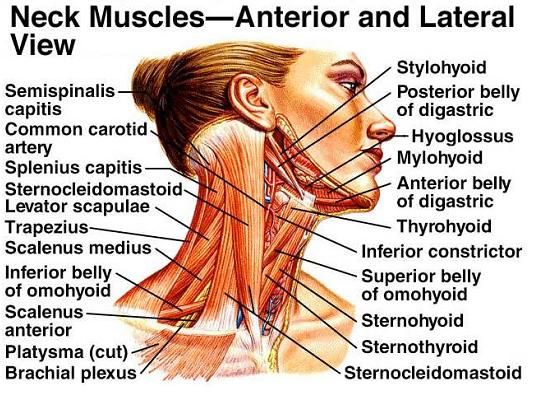
Anterior neck muscles include
- Platysma Thin sheet of muscle that covers part of your upper chest and shoulder, extending up the jaw. It helps with mouth and jaw motions, as well as tightening the skin in your neck and lower face.
- Sternocleidomastoid One of the largest muscles in the neck, move your head and control your jaw (temporomandibular joint), helping to extend your neck. It begins just behind your ear and stretches to your clerical one.
- Subclavius Stabilizes your clerical one when you move your arm and shoulder.
- Suprahyoids Four muscles that move your hyoid bone( a bone at the top of your neck, just below your jawline) when you speak and swallow.
- Infrahyoids Four muscles below your hyoid bone that move your larynx( voice box) over and down.
- Scalenes Three muscles that move your first two ribs over and below so you can inhale air when you breathe. They also help stabilize the cervical vertebrae( bones in your neck) and move the head.
Lateral neck muscles include:
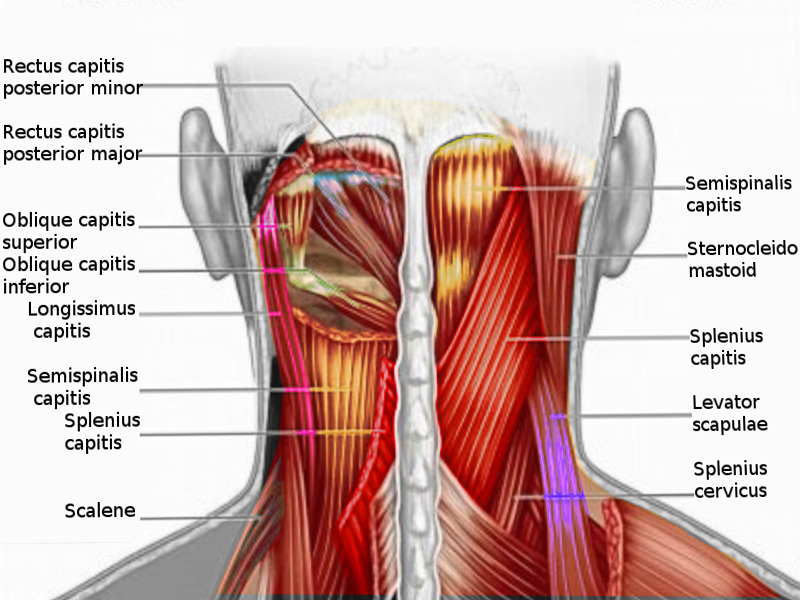
- Rectus capitis anterior and rectus capitis lateralis: Two muscles that manage head movements from the base of your skull.
- Longueurs capitis and longus colli: Two muscles help you rotate your head from side to side, as well as rotate and tilt your cervical spine.
Posterior neck muscles include
- Splenius capitis and splenius cervicis: Strap-like muscles in the back of your neck that helps you rotate and extend your head.
- Suboccipital muscles 4 muscles just below the occipital bone at the base of your skull. They help move your head in different directions.
- Transversospinalis muscles are Five muscles that help you move your head forward and backward, as well as bend it from side to side. They also help stabilize your backbone and move the cervical, thoracic and lumbar regions of your spine.
Causes of Neck muscle Strain
Some common causes of neck strain include:
- Poor posture or holding an awkward position. The neck’s muscles, tendons, and other soft tissues can turn overstretched when the head is held too far forward or tilted at an angle for too long. Some exemplifications include being hunched over a computer for several hours, gripping the phone between the ear and shoulder, or sleeping in a position that doesn’t support the cervical spine well. An increasingly common trouble is text neck, which describes neck pain that’s caused by looking down at a phone screen or other wireless device for too long or too constantly.
- Lifting objects too overweight. It’s likely for the neck to become overexerted and strained when lifting an object that requires too much work for the muscles.
- Collision or fall. A sudden impact can jar the head and cervical spine to move too suddenly for the muscles, which may lead to whiplash or other types of neck strain injuries. Some examples include bike, bus, or sports injuries, like in football.
- Performing a new exercise. Putting any muscle through a new type of activity that’s somewhat dynamic makes it more susceptible to strain, including in the neck. For instance, athletes are more susceptible to muscle strains at the start of a training season.
- Repetitive movements. Even for movements and loads that neck muscles can handle, doing too many repetitions can sometimes strain the muscles.
Neck muscle strain classification
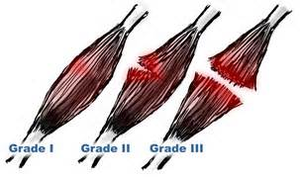
- Grade I: Mild strain with partial tearing. Pain is typically mild.
- Grade II: Moderate neck strain where more muscle fibers are torn. You could happen some muscle weakness as well as mild to moderate pain.
- Grade III: Most severe type of neck strain. The muscle has torn in a Grade III tear. Pain is severe.
Neck muscle strain sing and symptoms
- The most common sign of a neck strain is pain in combination with a restricted range of motion.
Other symptoms of neck strains include:
- Headache
- Muscle tightness
- Muscle spasms
- Numbness
- Inability to perform daily activities
- Weakness
- Tingling and numbness undesirable associated with nerve irritation or damage
- Stiffness in the neck
Neck strains complications
If a Grade II or III neck strain is left unprocessed, you could experience:
- Chronic pain
- Disability
- Headaches
- Loss of cervical motion
- Depression
Neck muscle strains risk factors
Different factors can increase your likelihood of developing a neck strain, including:
- Performing activities that require repetitive movements
- Sleeping in an awkward position
- Having surgery on the neck
- Heaving a bone fracture in the neck
- Maintaining a poor standing or sitting posture
Neck strains diagnosis
- Your doctor can diagnose a neck strain. During a clinic visit, your doctor will perform a physical test, take a full medical history, and order individual testing.
Physical examination
- Your doctor will evaluate your range of movement, examine your neck for abnormalities, and when necessary, perform a Spurling’s test to see if symptoms associated with nerve compression can be reproduced.
- In a few cases, your doctor will order an X-ray, MRI, or CT scan to confirm your diagnosis
Assessment
- Subjective assessment
- History with associated symptoms
- Mechanism of injury
- Inciting trauma-direction and extent of injury force
- Repetitious trauma- defective postural-related injuries
- Observation Strain injuries of the neck may present with an obvious deformity similar to a bulge or defect in the muscle belly.
- Posture
- Thoracic kyphosis
- Forward head
- Palpation
- Tenderness
- Swelling
Treatment of Neck muscle strain
Medical Treatment
For immediate
- Nonsurgical, Conservative treatment maximum muscle strains do not demand surgery if the muscle is fully damaged doctors suggest surgery If there is a partial gash also the athlete can replace when they are effortless and have normal strength and movement. This generally occurs following anywhere from many weeks to many months of significant treatment and therapy. When the muscle is fully damaged, the athlete may advantage from surgical repair. e tone- care of a muscle strain.
- Some therapists suggest avoiding inimical pain medicines that can extend your threat of bleeding — similar to over-
the-counter (OTC) medicine (naproxen sodium (Aleve) aspirin and ibuprofen (Advil, Motrin IB), — during the first 48 hours after a muscle strain. Acetaminophen (Tylenol) and others can be helpful for pain relief during this period. - A physiotherapist can help you to increase the strength and stability of the injured joint or limb. Your doctor may suggest that you stabilize with a brace. For some muscle injuries, neck muscle sprint surgery may be called.
To prevent swelling and pain as first aid by following RICE principal
- R- Rest
- I- Ice for cooling
- C- Compression tapping and splinting
- E- Elevation
the R.I.C.E approach

- Rest. Avoid activities that cause pain, swelling, or discomfort. don’t avoid all physical activity.
- Ice. though you are seeking medical facilities, ice the world right away. Use an associate degree ice pack or slush tub of ice and water for15 to 20 minutes every time occasion anytime and repeat every 2 to 3 hours. In contrast, you are awake for the primary few days once the injury.
- Compression. to assist stop swelling, compress the world with an associate degree bandage till the swelling stops. do not wrap it too tightly otherwise, you might hinder circulation. Begin wrapping at the top farthest from your heart. Loosen the wrap if the pain increases, space becomes numb or swelling is going on below the covered area.
- Elevation. Elevate the burned space on top of your heart’s extent, particularly at midnight, that permits gravity to assist scale neck swelling.
Physiotherapy treatment of Neck muscle strain
- The aim of activity treatment is
- Relieve neck muscle pain
- Reduce muscle swelling
- Increases back muscle strengths.
- Restore patient’s confidence
- Restore patients’ full functional activity
Phase one: First week
Electrotherapy
- Ultrasound has been used for tissue healing
- Increases blood circulation and mobility.
- To reduce swelling and pain
- Cryotherapy:
- Inflammation and swelling can be reduced by applying cryotherapy in form of ice packs, and cold water baths to the affected area.
- Continuous application of cold several times a day for 15-30 minutes at a time is recommended
- TENS
- Trans-cutaneous electrical nerve stimulation (TENS) may be able to help reduce pain and muscle spasms.
- IFT here are the main clinical applications for which IFT appears to be used:
- Pain relief
- Muscle stimulation
- Increased local blood flow
- Reduction of edema
Phase two:Two to four week
- Electrotherapy
After pain relief start the exercise
1) Chin Tucks
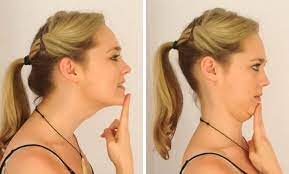
- Sit upright with your shoulders back and down, and remain in your eyes and chin position.
- Pull your head back and up tall as if you were going pulled by a string from the cap of your head.
- Do 10 rept.
- Do this exercise 3 times per day
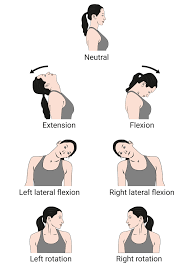
2) Neck Flexion
- Slowly bend your head forward, back to the starting position.
3) Neck Side bending
- Slowly tilt your head toward one shoulder, and again slowly repeat to the opposite side while remaining your face straight ahead
4) Neck Rotation
- Slowly rotate your head to look over one shoulder, then slowly Repeat to another side
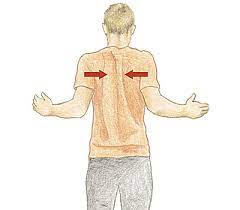
5) Scapular Retraction
- Squeeze shoulder blades together and down. Hold for 5- 10 seconds. Repeat 10 times.
- Go to sitting or standing with your back against a wall in an upright position.
- Remain chin tucked, arms by sides of the body, and avoid shrugging shoulders.

6) Shoulder roll
- Stand with your arms downwards at your sides.
- Roll your shoulders backward in a circular movement, and do 5 rotations. Then complete 5 rotations forward.
- Repeat 2–3 times.
Phase three: after four week
Stretching
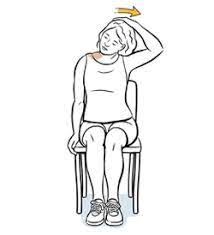
1) Upper Trapezius Stretch:
- Sit on the chair with good posture keeping your shoulders down.
- Grasp the base of the seat with one hand.
- Slightly turn your ear near to your shoulder until a comfortable stretch is filled on the opposite side of the neck.
- Hold that position for 15 seconds then relax.
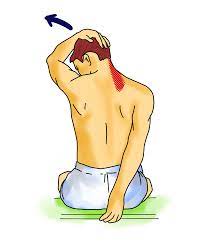
- Repeat to both sides 3 times.
2) Levator Scapula Stretch
- Sit upright in a chair, grasping the bottom edge with one hand.
- Turn your head to the opposite side, look down toward the opposite knee, and tuck your chin close to your chest. Gently squeeze your shoulder blades together and over.
- Place the opposite hand on the back of your head and gently pull down toward the knee until a stretch is felt.
- Hold 20-30 seconds.

- Make sure you remain sitting upright with your back straight.
3) Doorway Chest Stretch
- Stand just in the front and center of a doorway.
- Place palms and forearms on the frame of the doorway at a comfortable height.
- Take a small step ahead, pushing the pelvis forward until a stretch is felt in the front of your shoulders. Hold 20-30 seconds.
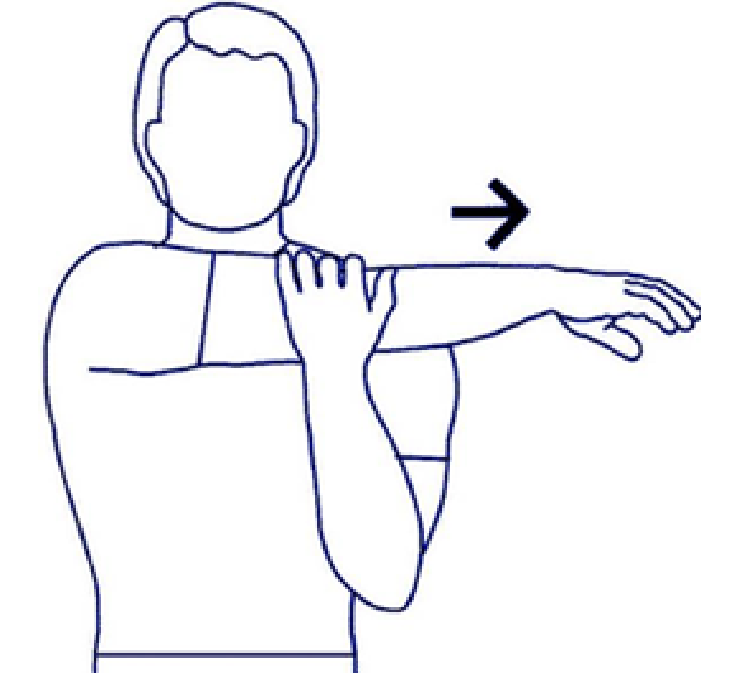
4) Posterior Capsule Stretch
- Stand with one arm took up in front of your body. Squeeze shoulder blade back.
- With the opposite hand hold the back of your arm and gently pull it across your body until a stretch is felt in the shoulder blade. Hold 20-40 seconds.
- Remain your shoulder blade drawn backward and chest upright.
Strengthening exercise
1) Cervical extension
- Remain your up and your neck straight and place your hands at the back of your head.
- Try to push your head backward during pushing forward with your hands.
2) Cervical flexion
- Bend your neck just forward and put your hand on your forehead.
- Try to band your head forward during pushing back with your hand.
3) Cervical side bending
- Remain your head straight and your chin level. Put your left hand on the left side of your head.
- Try to bring your head down to your left shoulder during pushing up with your right hand.
- Repeat the Side Bending, but to the right side with your right hand.
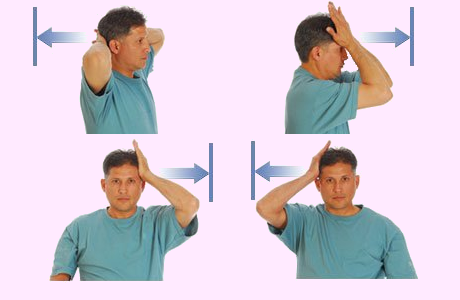

4) Cervical rotation
- Place your right hand at chin level and turn your head slightly to the left.
- Place your left hand on the left side of your face.
- Turn your head to the left during pushing it back with your left hand.

- Repeat the Rotation Exercise, but on the right side of your face and with your right hand
6) Wall Push Up
- Start with feet and shoulder width apart.
- Place hands opposite to wall slightly below shoulder level and elbows straight.
- Bend elbows while remaining your head in a neutral position. Repeat 10 times
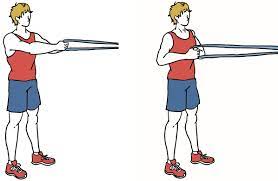
5) Theraband Row
- Stand with arms in front of the chest gripping the ends of a resistance band fixed at chest height.
- Bend elbows, pulling arms back opposite the resistance as if squeezing shoulder blades together.
- Remain your back straight and avoid shrugging shoulders.

6) Theraband Shoulder Extension
- Stand grasping the ends of a resistance band fixed above with arms at shoulder height and palms facing the floor.
- Drag your arms down to your sides, squeezing your shoulder blades together and downward.

- Secure elbows keep straight and avoid shrugging shoulders.
7) Reverse dumbbell fly
- Take two light dumbbells and stand, hinged at the waist at a 45-degree angle, with your arms hanging straight down.
- Remaining your neck neutral and your gaze down, begin to lift your arms out to the sides and up.
- Squeeze your shoulders jointly at the top of the move.
- 8–12 reps.
Neck muscle strains prevention
Although all neck strains can not be prevented, you can prevent some cases by following these guidelines
- Practice using good posture while standing and sitting.
- Take breaks if you’re traveling long distances or sitting in the same position for an extended period.
- Avoid carrying heavy things or bags on your shoulders.
- DO the proper warm-up before some exercises or sporting activity.
- Stretch after exercising or playing sports
- Avoid immediate intense strength training and build strength gradually
- Do Regular stretching and strengthening exercises for your sports, fitness, or work exertion, as a part of your overall physical activities
- An exercise program can help to minimize your danger of muscle strains.
- Try to be in a shape to play your sport; don’t play your sport to get in shape.
- If you have a physically demanding occupation, regular exercise can help to help injuries.
- Follow a healthy diet and an exercise program to maintain a healthy weight. The overweight can put added pressure on the muscles, making muscle strains again probable to do.
General Posture Guidelines
- Follow these recommendations to help reduce neck and shoulder pressure and the constant need to stretch.
- Change position, or perfectly, stand every 20- 30 minutes.
- Be Aware of poor postural habits and slouching
- Keep your eyes positioned and sit upright as if a string through the top of your head is drawing you toward the ceiling.
- Perform cervical and scapular retraction to action forward head and rounded shoulder positions assumed with long duration computer work or driving
- Avoid shrugging shoulders

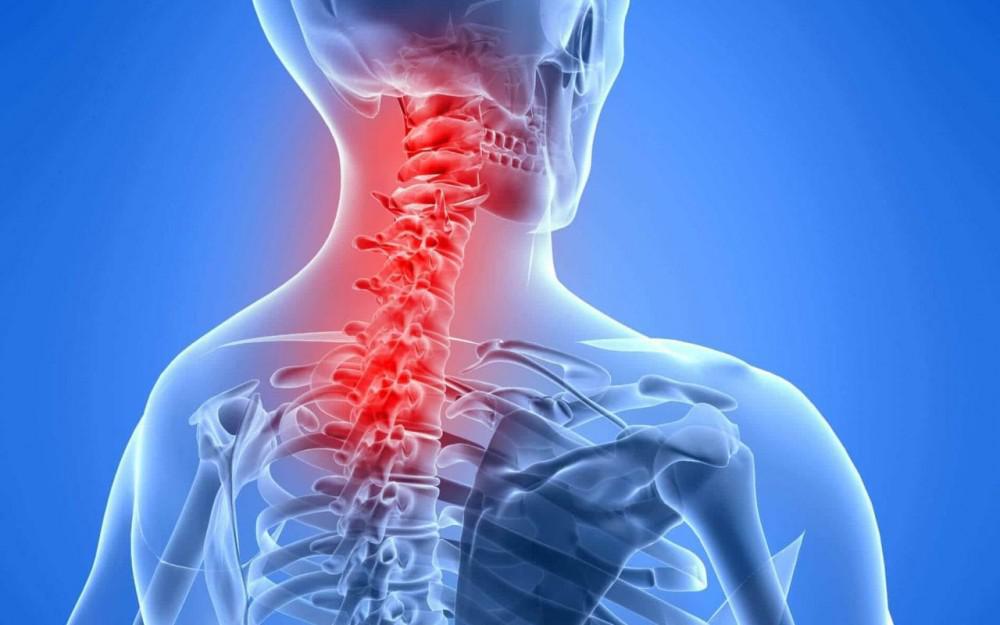



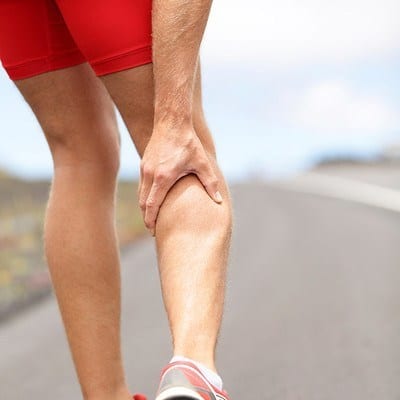


One Comment